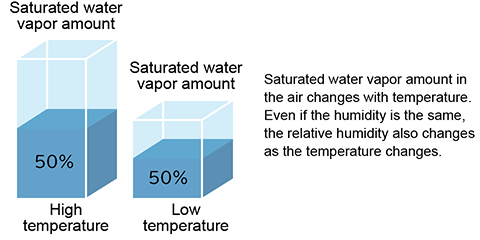Relative humidity (RH) is the ratio of water vapor actually in the air compared to the maximum amount of water vapor allowed (Saturated water vapor amount).
It is expressed as a percent and an important tool in weather forecasting as it references the water vapor content in the air. In general, "humidity" refers to Relative humidity, and the measurement method is defined in the Japanese Industrial Standard JIS Z 8806.
Saturated water vapor amount in the air changes with temperature. Even if the amount of moisture in the air is the same, the relative humidity also changes as the temperature changes.
Another way to measure humidity is Absolute humidity. It represents the water vapor in the air regardless of temperature. It is expressed as grams cubic meter of air (g/m3). If the amount of moisture in the air does not change, absolute humidity will not change with changes in temperature.
Relative humidity is widely used to describe the environment in daily life and manufacturing and inspection areas of products. Absolute humidity is not commonly used since relative humidity affects how we feel the temperature.
During product manufacturing, Condensation on the products could affect quality. Using relative humidity is easy to maintain the optimal environment where condensation is less likely to occur.
Generally, relative humidity between 45 to 50 percent feels comfortable for electronic equipment usage. If the humidity is too high, the possibility of condensation increases, and if it is too low, the possibility of static electricity increases.

Information on related articles in Technical Knowledge
- What is a Power Supply? Types and Applications
- What is a Power Supply? (Basic Knowledge)
- Safety and Usage of High Voltage Power Supply
- An Introduction to DC Power Supplies
- What is a Bipolar Power Supply? (Basic Knowledge)
- Electronic Loads: An Introduction to Principles, Types, and Uses
- What is AC Power Source? - Basic Knowledge -
- Linear vs. Switching Power Supplies: Key Differences Explained
- Types of X-ray Tubes and High-voltage Power Supplies
- High Voltage Measurement Method
- How to Choose a DC Power Supply: Key Points to Consider
- Difference between DC power and AC power
- A Beginner's Guide to Using Power Supplies Safely
- A Guide to Using DC Power Supplies Correctly and Safely
- HVPS for Lab Analyzers: Key Considerations for Stability and Noise
- Amplifier Basics: Principles, Operation, and Key Considerations
- Method of Generating Direct Current (DC) Power


